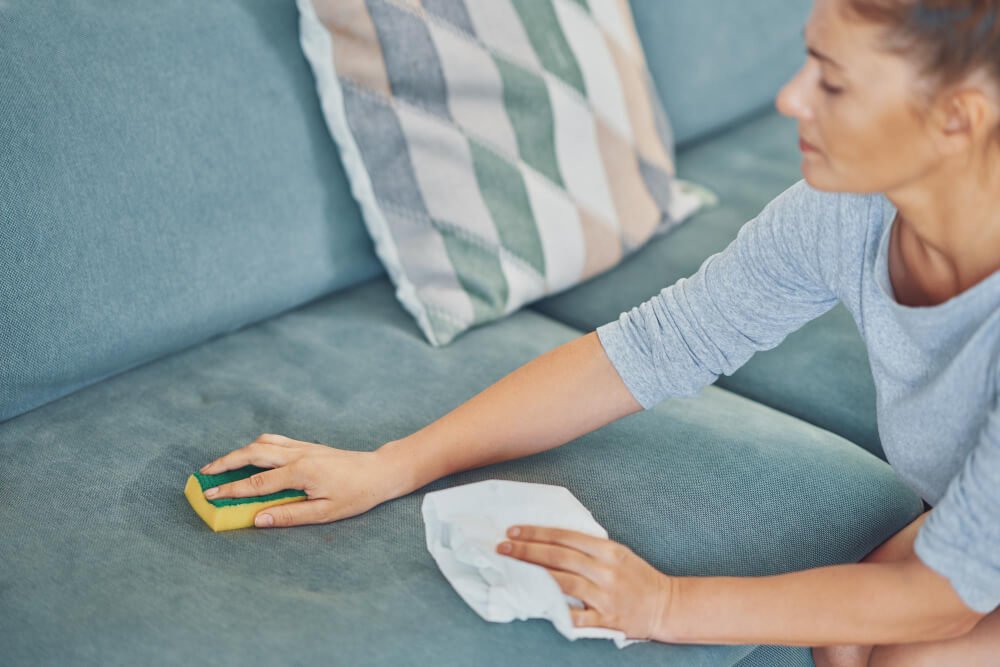Before diving into the cleaning process, it’s essential to determine the type of fabric your couch is made of. Different fabrics require different cleaning methods, and using the wrong one could damage your couch. Check the label or manufacturer’s instructions to identify the fabric and any cleaning recommendations. In this article, we’ll walk you through the steps to keep your couch looking and feeling like new. So, grab your cleaning supplies, and let’s get started!
The Codes the Upholstered Furniture Industry Uses
The upholstered furniture industry uses four standard codes to identify the appropriate cleaning method for different types of fabrics. These codes are W, S, WS, and X.
- The W code indicates that the fabric can be cleaned with water-based cleaners.
- While the S code recommends solvent-based cleaners.
- The WS code means that either water-based or solvent-based cleaners can be used, depending on the type of stain.
- Finally, the X code means that the fabric can only be cleaned with a vacuum or light brushing, as it is too delicate for any cleaning solution.
Understanding these codes will help you choose the appropriate cleaning method for your fabric couch.
How To Deep Clean Fabric and Microfiber Couches
Deep cleaning of your fabric or microfiber couch is essential to maintain its appearance and prolong its lifespan. Here is a detailed explanation of how to accomplish it:
- To remove all the loose dirt, dust, and debris, thoroughly vacuum the couch.
- Check the manufacturer’s label for any specific cleaning instructions or recommendations.
- Test the cleaning solution on a small, inconspicuous couch area first to ensure it doesn’t damage the fabric.
- For fabric couches with a W code, mix a small amount of mild detergent or upholstery shampoo with water, and use a soft-bristled brush or sponge to scrub the entire surface of the couch gently. For microfiber couches, use rubbing alcohol or a specialized microfiber cleaner instead.
- For fabric couches with an S code, use a solvent-based cleaner such as dry cleaning fluid, rubbing alcohol, or specialized solvent-based upholstery cleaner.
- For fabric couches with a WS code, use either water-based or solvent-based cleaner, depending on the type of stain. Always test the cleaner on a small, inconspicuous area first.
- Allow the couch to air dry completely, and avoid sitting on it until it fully dries.

How To Clean a Leather Couch
Cleaning a leather couch requires a different approach than cleaning a fabric or microfiber couch. The following are the steps for cleaning a leather couch:
- First, thoroughly vacuum your couch to remove any loose dust, filth, and debris.
- Test any cleaning solution on a small, inconspicuous area of the leather first to ensure it doesn’t damage or discolor it.
- Use a soft-bristled brush or sponge to gently clean the leather surface after combining mild detergent with water.
- Alternatively, you can use a specialized leather cleaner or conditioner.
- After carefully drying the leather with a clean towel, remove the cleaning solution with a moist cloth.
- Apply a leather conditioner to the couch to restore its natural oils and prevent it from drying out and cracking. Be sure to follow the instructions on the conditioner carefully.
- Avoid harsh chemicals or abrasive cleaners on the leather, as they can damage or discolor it.
- Regularly dust and wipe down the leather with a soft, dry cloth to keep it looking clean and shiny.
How To Disinfect a Coach
Although steam cleaning is a fantastic way to sanitize a sofa, other options exist if you don’t have one or want to hire a cleaner. Rubbing alcohol is an excellent choice because it may kill germs and diseases.
- 2 gallons of rubbing alcohol
- 1 cup of water
Combine the abovementioned ingredients in a spray bottle and softly wet the couch. Take care not to overwet it. If possible, remove the cushions and spray the frame and all sides of the cushions individually. Allow the couch and cushions to dry naturally.
Conclusion
Cleaning a fabric couch is important to keep it looking good and smelling fresh. Before cleaning, remove any loose debris or dirt by vacuuming or using a soft brush. It is recommended to clean your fabric couch every 6 to 12 months or more frequently if it is heavily used or if you have pets or children in your home. The fabric of your couch will determine the sort of cleaner you choose, so always follow the manufacturer’s instructions or consult a professional cleaner before cleaning. Remember to be careful with bleach and high heat as they can damage or discolor the fabric. If you have any doubts or concerns about cleaning your fabric couch, it is best to consult with a professional cleaner.
Frequently Asked Questions
It is recommended to clean your fabric couch every 6 to 12 months or more frequently if it is heavily used or if you have pets or children.
Use a stain remover designed for an upholstery to remove stains from a fabric couch. Alternatively, you can create your stain remover by combining vinegar and water in equal amounts, then rubbing it on the stain. Blot the stain with a clean cloth until it is removed.
You can use a steam cleaner on a fabric couch, but follow the manufacturer’s instructions carefully. Steam cleaning can effectively remove dirt and grime from the fabric, but it may not suit all fabric types.










